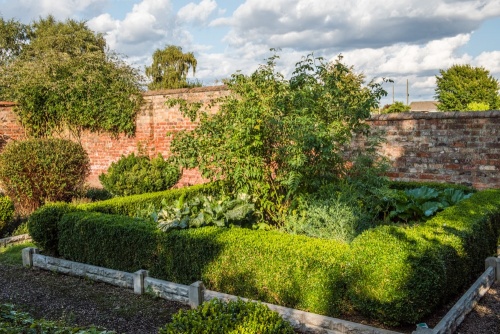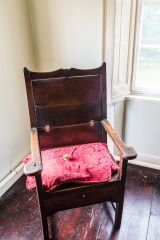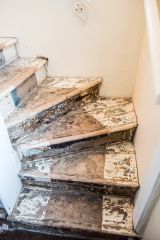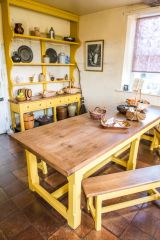
Epworth Old Rectory was built in 1709 to house the rector of St Andrew's Church in Epworth, replacing an earlier rectory which had dramatically burned down. The first rector to take up residence was Samuel Wesley. Two of Wesley's sons are more famous than their father; John and Charles Wesley are credited with establishing the Methodist Church.
The Old Rectory served as the residence for the rector of St Andrew's Church until 1954. It stood empty for several years before it was purchased by the World Methodist Council.
The WMC planned to restore the building and open it to the public as a museum, but in the meantime, the building had to pay its own way so it was launched as a bed and breakfast. Paying guests could sleep under the 'Whitney Quilt', the same bed covering used by John Wesley when he lived here. Now the rectory is a full-time museum (and no one is even allowed to touch the Whitney Quilt!)

History
Samuel Wesley was named as the rector of Epworth, Lincolnshire in 1695. It was not an auspicious appointment. Samuel was a committed Royalist, a Tory, and an academic. He had very little in common with the parishioners he was sent to nurture. Samuel Wesley was regarded with suspicion and on occasion with outright antagonism. His strict moralist outlook made him very unpopular with his parishioners.
Samuel and his wife Susanna had at least 19 children, including two sets of twins, of whom just 10 survived childhood. Susanna looked after the children's education and followed a rigorous, methodic approach that was later adapted by Charles and John in the religious studies. All three sons obtained MA degrees at Oxford University and all three became clergymen.
In February 1709 a fire broke out in the thatched rectory. There is a suspicion that the fire was started by arson, another sign of how much Samuel Wesley's preaching had provoked local antagonism. John, then aged just six, was dramatically rescued from the flames like 'a brand plucked from the burning'. One man had to stand on another man's shoulders and pluck John from a first-floor window before the building collapsed.

The event is captured in a dramatic painting in the stairwell. The rescue was a pivotal event in John Wesley's life and gave him the sense that God had a purpose for him, a mission to fulfil.
With the rectory burned to the ground a new rectory building was needed to house the Wesley family. The result is the elegant red-brick Old Rectory we see today. The family moved into the new rectory in December 1709. Here John, Charles, their brother Samuel and seven sisters spent the remainder of their childhood.
The cost of the new rectory building was born entirely by Samuel Wesley. He could have saved quite a bit of money by rebuilding in timber and thatch, like the old rectory that had burned down, but Samuel opted for a much more expensive brick and stone structure. Perhaps he was trying to make a statement to the arsonists that he would not be intimidated.
Unfortunately, the expense of building the Old Rectory and furnishing it left Samuel Wesley in debt for the rest of his life. It also caused ongoing tension between Samuel and Susanna.

The Wesley family lived at the Old Rectory until Samuel Wesley died in 1735. Susanna spent time with several of her children and died in 1742 while visiting John Wesley in London. She is buried at Bunhill Fields, opposite Wesley's Chapel and House. John Wesley returned to Epworth in 1742, and he came back to preach every other year until 1790. He would stay at the Red Lion Inn and preach in the open air by the market cross.
Behind the rectory building is a physic garden, a walled garden area featuring plants in John Wesley's book, 'Primitive Physic: an Easy and Natural Method of Curing Most Diseases'. As the title suggests, these were plants that Wesley believed could be used in the treatment of diseases.
Ghostly Goings-On
Legend has it that the Old Rectory is haunted. The Wesley family were reported to have been terrified by the unexplained noises in the house. Servants living under the eaves first reported strange noises, and soon all the family were hearing unexplained banging noises. The family believed that the haunting was the work of 'Old Jeffrey', a servant who had recently died.
When Samuel Wesley heard the noises he began to feel concerned for his family's safety. On one occasion he entered the children's nursery and exhorted the ghost to leave his family in peace, but to no avail.

John Wesley was away from home, studying in London at the time, but letters from his sisters to him have been preserved un which they tell him of the ghostly noises. The younger girls reported being pinched when there was no one in the room, and objects were thrown across the room.
In March 1716 the ghostly noises ceased as suddenly as they had begun. Since then, visitors have reported hearing an occasional groan or a banging noise in the uppermost chambers of the house.
Visiting
All visits are by guided tour, which takes about one hour. Our guide was exceptional, and really helped bring the house and its inhabitants to life.
On the ground floor are a dining room and kitchen, while on the first floor are family bedrooms, one converted into an exhibition area. Here you will find rare first editions of Wesley's book, letters, and other personal items.

Many of the house furnishings belonged to the Wesley family, others are simply there to show how the house would have looked during the time the Wesleys lived here. one of the most interesting pieces of furniture is a beautifully carved chair from the missionary ship, the 'John Wesley'.
Other items that caught our eyes include John Wesley's journal, and a gold mourning ring made to remember John John Romney (1710-1750). Romney was Samuel Wesley's curate and became rector of Epworth after Wesley's death in 1735. Romney courted Hetty Wesley, then transferred his affections to her sister Martha.
Another personal item on display is a wooden box made from a sycamore tree planted by John Wesley in Epworth churchyard. In the dining room a large iron key to the rectory's front door used by the Wesleys.
The Old Rectory is an absolute delight to visit. You really get a sense of the Wesley family and their daily lives, with a wealth of personal items and period furnishings. The Old Rectory is very well signposted from the village centre and is extremely easy to reach from any of the central visitor parking areas in Epworth.
About Epworth Old Recory
Address: 1 Rectory Street,
Epworth,
Lincolnshire,
England, DN9 1HX
Attraction Type: Historic Church
Location: On Rectory Street, just off Albion Hill. Well signposted from the centre of Epworth. Several paid parking areas within a short stroll.
Website: Epworth Old Recory
Location
map
OS: SE785035
Photo Credit: David Ross and Britain Express
POPULAR POSTS
HERITAGE
 We've 'tagged' this attraction information to help you find related historic attractions and learn more about major time periods mentioned.
We've 'tagged' this attraction information to help you find related historic attractions and learn more about major time periods mentioned.
Find other attractions tagged with:
John Wesley (Person) -
NEARBY HISTORIC ATTRACTIONS
Heritage Rated from 1- 5 (low to exceptional) on historic interest
Epworth, St Andrew's Church - 0.3 miles (Historic Church) ![]()
Wesley Memorial Methodist Church - 0.3 miles (Historic Church) ![]()
Burringham, St John's Church - 4.8 miles (Historic Church) ![]()
Gainsborough, All Saints - 8.6 miles (Historic Church) ![]()
Gainsborough Old Hall - 8.9 miles (Historic House) ![]()
Saundby, St Martin's Church - 9.7 miles (Historic Church) ![]()
Mattersey Priory - 10.1 miles (Abbey) ![]()
Normanby Hall - 10.2 miles (Historic House) ![]()
Nearest Holiday Cottages to Epworth Old Recory:
Misterton, Nottinghamshire
Sleeps: 4
Stay from: £489 - 2295
More self catering near Epworth Old Recory











